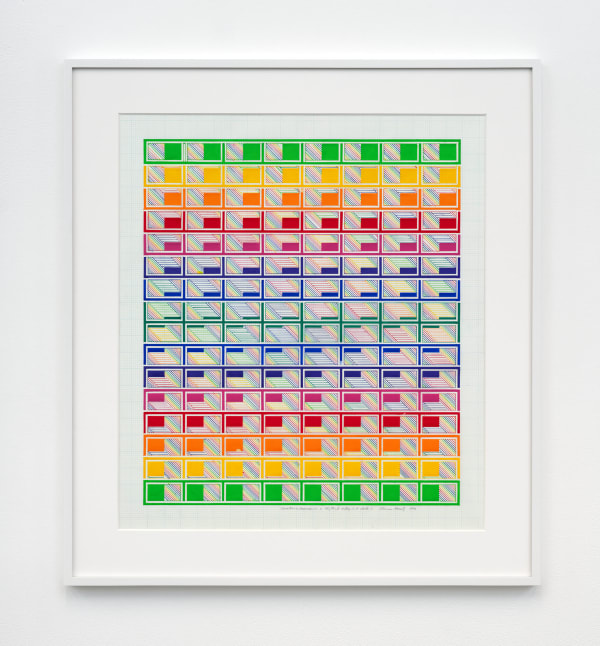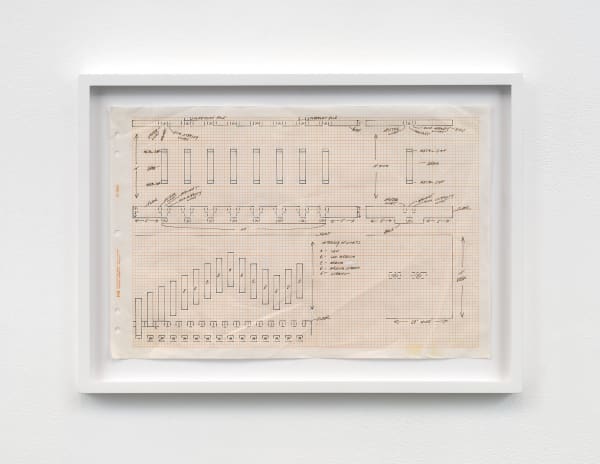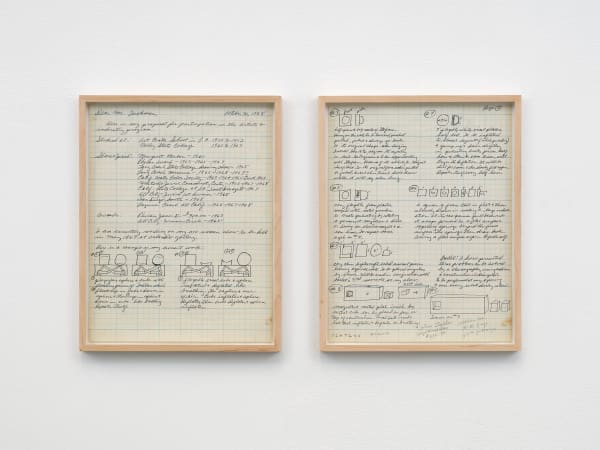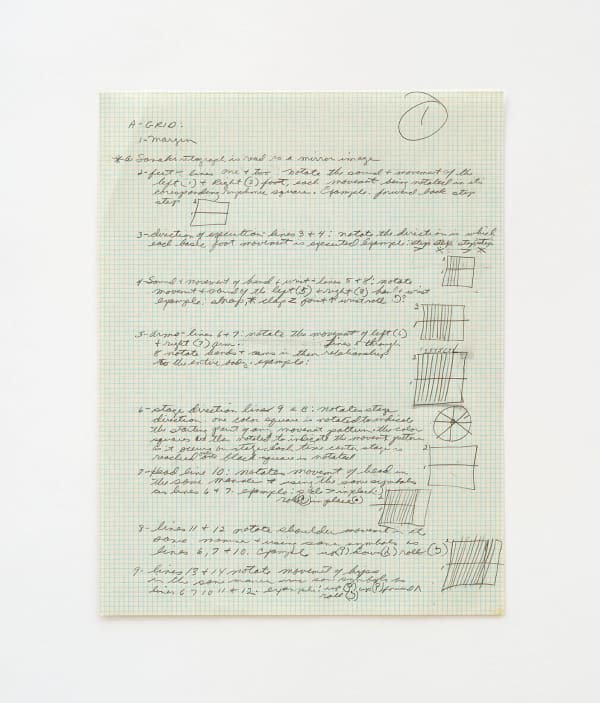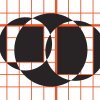Channa Horwitz: Evolving Systems
Evolving Systems surveys the evolution of Channa Horwitz’s (1932–2013) singular visual language from 1968 until the early 2000s. For over four decades, Horwitz examined the relationship between structure, limitation, and variation. Arrestingly detailed and conceptually charged, her works transformed visual systems into both autonomous compositions and notational scores for movement, sound, and performance. Guided by her own rigorous and iterative investigations, Horwitz consistently experimented with limiting her options as a means of refining precise systems of composition.
Underlying all of Horwitz’s work is the thesis that order and chance are inseparable, each emerging from the other through time. “I feel that through chance comes structure,” she wrote, “or that if chance plays out long enough, it will become structure. If we cannot see the structure in chance, we are too close to see it. The theory behind my work is that through structure comes apparent chance.” Her visual systems, while meticulously considered and executed, embody this philosophy, open to translation while maintaining an exacting commitment to her generative logic.
Spanning three rooms of the gallery, the exhibition traces the artist’s progression from her seminal 1968 works, where she began translating temporal experience into visual systems, to her later works that transform those systems into intricate interplays of line, color, and rhythm.
The exhibition starts with a presentation of drawings and documents from the Art and Technology Proposal (1968)—a project that never came to fruition but was conceived for Maurice Tuchman’s landmark Art and Technology program at LACMA. For the proposal, Horwitz envisioned a room-sized sculpture composed of eight light beams of varying intensity, magnetically suspended in space and moving vertically between the floor and ceiling. The drawing that accompanied the proposal, an attempt to diagram the beams’ choreographed movements over a ten-minute period, marked the first time Horwitz used graph paper to envision time in relation to movement and space. This act, of converting duration into a visible score, would become the foundation of her lifelong system of notation: Sonakinatography (a term coined to mean sound, motion, notation).
To allow herself to see time, Horwitz used the grid of graph paper to plot colors or symbols inside the squares. She began by assigning eight colors to eight entities, each with a numerical duration, forming what she called “instruments.” Green moved on every beat, blue every second beat, and so on, following a circular chromatic logic that yielded not only a composition but an orchestration. Across the decades, Horwitz’s exploration of Sonakinatography remained steadfast in its logic yet infinitely varied in its outcomes.
Apart from several never-before-shown Sonakinatography works from the late 1960s, the exhibition also presents documentation and recreations from Horwitz’s first gallery exhibition at Orlando Gallery in 1969. That exhibition included Horwitz’s early kinetic sculptures, Sonakinatography drawings, a choreographed dance with costumes she designed, a film of the rehearsal projected on a three-dimensional sphere, and live spoken poetry. These works manifest what Horwitz described as a “consistent expression about movement.”
Further into the gallery, the exhibition highlights later works that demonstrate Horwitz’s simultaneous progression and reduction of choice. Maintaining her commitment to the concept of “eight,” the artist extends the eight plotted colors from Sonakinatography into a system of chromatic lines and their associated angles. The drawings in this space, from the 1970s to the early 2000s, trace Horwitz’s deepening exploration of line, color, and repetition. By experimenting around and upon her foundational principles, Horwitz produced increasingly resonant works that multiplied her logic into new tangential series such as Variance and Subliminal-Covariance. In these series, Horwitz maintains her deductive logic of angles and color while introducing experiments involving shapes and scales through moiré patterns. Canon Eleven Moiré Two (1984), in particular, demonstrates Horwitz’s ability to imply movement through density. By layering and alternating the eight corollary angles of line and color, she produces structures of vibratory complexity.
The exceptional vision of Horwitz’s work reflects her pursuit of freedom through a logic of simultaneous limitation and investigation. For Horwitz, structures of predetermined choices liberated—never restricted—the act of creation, allowing her to explore the greater depth and essence of the work.
-
 Channa Horwitz, Canon Eleven Moiré Two, 1984
Channa Horwitz, Canon Eleven Moiré Two, 1984 -
 Channa Horwitz, Variance - Green Moiré Square, 2007
Channa Horwitz, Variance - Green Moiré Square, 2007 -
 Channa Horwitz, Canon Eleven Moiré One, 1984
Channa Horwitz, Canon Eleven Moiré One, 1984 -
 Channa Horwitz, Orange Subliminal-Covariance (#6-8), 2007
Channa Horwitz, Orange Subliminal-Covariance (#6-8), 2007 -
 Channa Horwitz, Cube Inside the Ball (or Ball Inside the Cube), 1986
Channa Horwitz, Cube Inside the Ball (or Ball Inside the Cube), 1986 -
 Channa Horwitz, Orange Subliminal-Covariance, 2007
Channa Horwitz, Orange Subliminal-Covariance, 2007 -
 Channa Horwitz, 1/4 Noisy, 1998
Channa Horwitz, 1/4 Noisy, 1998 -
 Channa Horwitz, Rhythm of Lines, c. 1983
Channa Horwitz, Rhythm of Lines, c. 1983 -
 Channa Horwitz, Variation and Inversion on a Rhythm II Matrix in 4 Parts I, 1990
Channa Horwitz, Variation and Inversion on a Rhythm II Matrix in 4 Parts I, 1990 -
 Channa Horwitz, Sonakinatography “Error at 648", 1980
Channa Horwitz, Sonakinatography “Error at 648", 1980 -
 Channa Horwitz, Dome Inside Square / At the Tone the Time Will Be, 1968
Channa Horwitz, Dome Inside Square / At the Tone the Time Will Be, 1968 -
 Channa Horwitz, Art and Technology Proposal” "Suspension of Vertical Beams Moving in Space, 1968
Channa Horwitz, Art and Technology Proposal” "Suspension of Vertical Beams Moving in Space, 1968 -
 Channa Horwitz, Sonakinatography Movement I Sheet C 2nd Variation, 1969
Channa Horwitz, Sonakinatography Movement I Sheet C 2nd Variation, 1969 -
 Channa Horwitz, Sonakinatography (Diminished) Composition Xl, 1980
Channa Horwitz, Sonakinatography (Diminished) Composition Xl, 1980 -
 Channa Horwitz, Sonakinatography Composition lll, 1969
Channa Horwitz, Sonakinatography Composition lll, 1969 -
 Channa Horwitz, Sonakinatography, Circa 1968
Channa Horwitz, Sonakinatography, Circa 1968 -
 Channa Horwitz, Sonakinatography, N.D.
Channa Horwitz, Sonakinatography, N.D. -
 Channa Horwitz, Sonakinatography, 1969
Channa Horwitz, Sonakinatography, 1969 -
 Channa Horwitz, Breathers, 1968
Channa Horwitz, Breathers, 1968 -
 Channa Horwitz, Breathers, 1968
Channa Horwitz, Breathers, 1968 -
 Channa Horwitz, Color Angle Sequential Progressions, 2005 - 2006
Channa Horwitz, Color Angle Sequential Progressions, 2005 - 2006 -
 Channa Horwitz, Sonakinatography 'Sculptures Showing Movement", 1968
Channa Horwitz, Sonakinatography 'Sculptures Showing Movement", 1968 -
 Channa Horwitz, Sonakinatography 1, Movement #ll for Multi-Media, 1968
Channa Horwitz, Sonakinatography 1, Movement #ll for Multi-Media, 1968 -
 Channa Horwitz, Sonakinatography l Varied Movement for Multi-media, Circa 1969
Channa Horwitz, Sonakinatography l Varied Movement for Multi-media, Circa 1969 -
 Channa Horwitz, Art and Technology Proposal – Beams and intensity of lights, 1968
Channa Horwitz, Art and Technology Proposal – Beams and intensity of lights, 1968 -
 Channa Horwitz, Varied Movement for Multi Media Sculpture, 1969
Channa Horwitz, Varied Movement for Multi Media Sculpture, 1969 -
 Channa Horwitz, To Maurice Tuchman proposal for Experiments in Art and Technology, 1968
Channa Horwitz, To Maurice Tuchman proposal for Experiments in Art and Technology, 1968 -
 Channa Horwitz, Sonakinatography “2” – A system for the Notation of Sound and Movement as applied to Dance, 1969
Channa Horwitz, Sonakinatography “2” – A system for the Notation of Sound and Movement as applied to Dance, 1969 -
 Channa Horwitz, Invitation, framed, for Orlando Gallery solo show, 1969
Channa Horwitz, Invitation, framed, for Orlando Gallery solo show, 1969










